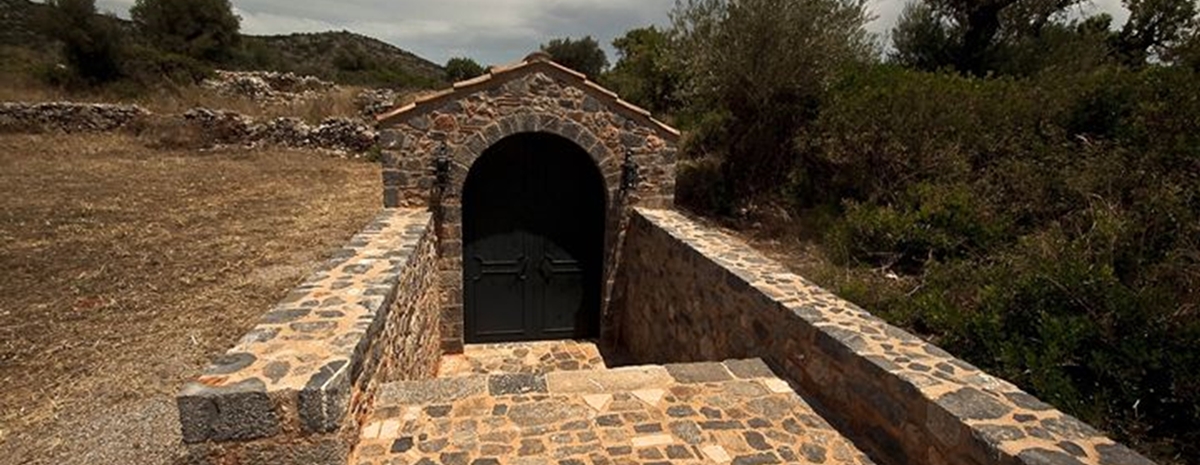KASTANIA

PLEASE NOTE THAT ALL THE PHOTOGRAPHS ON THE SITE ARE CLICKABLE LINKS

PLEASE NOTE THAT ALL THE PHOTOGRAPHS ON THE SITE ARE CLICKABLE LINKS
Kastania Cave(or St Andrew's Cave named after the nearby small church) is one of the most impressive caves of Greece and it can be found near the village of Kastania on the southern tip of the Peloponnese, about 17km from Neapoli.
The route follows the winding mountain road leading to the forest-covered eastern slopes of Mount Parnon.
The cave can be accessed by following the circular route that connects Neapoli with the mountain villages Kastania, Ano Kastania, Faraklo and Mesochori.
Buses and other large vehicles should take the road through Mesochori and avoid the route passing through Kastania.
The story of the discovery of the cave is that a local shepherd watched bees enter and come out of a crack in the rocks of his field and how, his need for water, prompted him to break open the fissure only to discover this beautifully unique and rare cave.
The true size of the Kastania Cave is not known since it has not been extensively explored or studied. It may be as large as that of Diros or other caves of the Southern Peloponnese. The part that has been explored covers an area of 1,500 m2, shaped in two levels with the visitable part 500 m in length.
However, it is not size that makes this cave so unique. What makes this cave different - and a true speleological wonder - is the abundance, richness and diversity of the truly unique stalactite and stalagmite forms that nature has created.
The cave was formed from limestone of Jurassic age (195-145 million years old) as a result of geological turmoil and chemical reaction.
The cave formations are made of calcium carbonate in the shape of crystals enriched with metal oxides from the subsoil, creating a seven colour palette. Notice the remarkable and rare discs, flat stalagmites, eccentric stalactites, and helictites.
Rich in density and variety of shapes, colors and figures, Kastania Cave is classified as second of its kind in Europe.
Nature needed three million years to create this fantasy with its unparalleled decor and numerous impressive formations such as enormous red and white waterfalls, the gigantic columns, the curtains and the sheets that cascade like waxworks from the roof.
You will also see formations which look like coloured octopuses, corals, medusas, little elephants, mushrooms, birds, other funny shapes, exotic plants and other large rock structures.
A spiral corridor will lead you down to the First Chamber which is decked with stalagmites in various shapes as well as columns.
To the left, lies the Red Chamber following a downward direction. On the right you will see a series of beautiful pillars separating this chamber from the Water Chamber, a large and impressive room with a small pond inside it, after which it was named.
On your right there is a row of enormous stalagmites on a higher level, resembling a large balcony, which separate the Water Chamber from the Apartments of the Bushes.
Next is the Chamber of Mushrooms, then descend the Royal Stairway, decked with cactus-shaped stalagmites, then to the Chamber of Fir Trees.
You visit the Chamber of Candles, going up another flight of stairs. Shaped like Paschal Candles, the alabaster stalagmites have formed two structures.
Descend the Stairway of the Water lilies which leads back to the Chamber of Fir Trees and then to the Chocolate Chamber which was named after a pillar that looks like a bar of chocolate, at its centre.
The Alabaster Chamber has snow-white and transparent decoration in sharp contrast to the former chamber in terms of colour and quality.
Just before you complete your visit, you will reach a Large Balcony, above this lies the Apartment of the Bushes. Follow the spiral corridor through them and you will enjoy a fine view of all the chambers from the top.
Seeing these formations makes it easy to understand why they were so named. You do not have to be a speleologist or geologist to appreciate the magic forces of nature that have shaped these forms.
With a little luck you will meet a cave resident, the blind and deaf dolichopoda which is a type of transparent spider with long antennae.
A very knowledgeable Greek guide - explains in both Greek and perfect English the facts and the history of the Cave. Tours every hour. Each tour lasts 30-40 min.
Parking is available near the cave entrance and a cafe operates outside the cave. Nearby is the old church of St. Andrew.
Tickets prices: Adults: 7.00 Euros. Adults as part of a group: 5 euros. Children, Students and Concessions: 3 euros.
Days and hours of operation: From 24/12/2018 until 31/05/2019 every Saturday & Sunday from 10am to 4pm. Then Daily from 1st June until the end of September 10am to 4pm.
For group visits (clubs, schools etc) and information call the following telephone numbers: +30 2734360100-115, +30 6986555444 (Ms Karvouni)